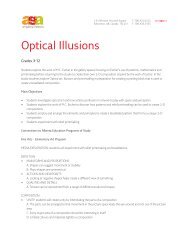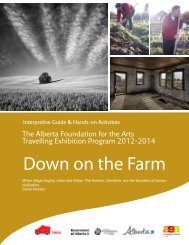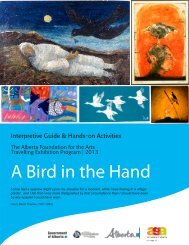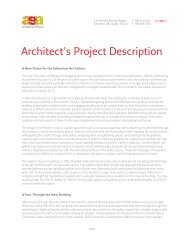Urban Animals - Art Gallery of Alberta
Urban Animals - Art Gallery of Alberta
Urban Animals - Art Gallery of Alberta
You also want an ePaper? Increase the reach of your titles
YUMPU automatically turns print PDFs into web optimized ePapers that Google loves.
The <strong>Alberta</strong> Foundation for the <strong>Art</strong>s Travelling Exhibition Program<br />
Elements and Principles <strong>of</strong> Design Tour<br />
SPACE: The area between and around objects. It can also refer to the feeling <strong>of</strong> depth<br />
in a two-dimensional artwork.<br />
See: Habitat for a Beaver, 2012 by Jason Carter<br />
What is space? What dimensions does it have?<br />
Space includes the background, middleground and foreground. It can refer to the<br />
distances or areas around, between or within components <strong>of</strong> a piece. It may have two<br />
dimensions (length and width) or three dimensions including height or depth.<br />
What do you see in this work? What is closest to you? Farthest away? How do you know<br />
this?<br />
In this work we see trees, a beaver, a beaver lodge, a lake and background trees and<br />
mountains. The trees on the far right are closest to the viewer. This is shown by them being<br />
larger than anything else and by the fact that the viewer can not see their bottoms. The<br />
mountains on the top right are farthest away. This is shown by their light grey colour and the<br />
lighter colour <strong>of</strong> the trees ‘in front’ <strong>of</strong> them.<br />
In what other way has Carter created a sense <strong>of</strong> space?<br />
The artist has used a variety <strong>of</strong> lines to help develop a sense <strong>of</strong> space in the work. The<br />
horizontal lines <strong>of</strong> the lake and in the mountains lead the eye from the left side <strong>of</strong> the picture<br />
to the vertical lines <strong>of</strong> the trees on the right. The vertical lines <strong>of</strong> these trees lead the eye ‘up’<br />
the picture to the mountains, which are farthest away. The artist also uses overlapping shapes<br />
and changes in size to create space and depth. The beaver at the ‘front/bottom’ <strong>of</strong> the picture<br />
overalps the horizongal bands <strong>of</strong> water and appears in front <strong>of</strong> the beaver lodge, which in turn<br />
overlaps the bands behind it and so appears closer than the mountains. The horizontal bands<br />
are also different tones <strong>of</strong> colour which lead the eye back into the space.<br />
What else in the work may create a sense <strong>of</strong> depth? How does it do this?<br />
The artist has deliberately used a wide tonal scale from dark black to pure white to create<br />
contrast in the work. Placing a dark green shape <strong>of</strong> ground in the foreground attracts our<br />
attention and we notice the contrast <strong>of</strong> the beaver’s tan coloured body on the dark surface. The<br />
light tan <strong>of</strong> the beaver’s body is similar in colour to the beaver lodge whch causes the viewer’s<br />
eye to jump to the middle <strong>of</strong> the picture plane. Finally, the changing tones <strong>of</strong> green for the lake<br />
and background trees create further space/depth in the work.<br />
AFA Travelling Exhibition Program, Edmonton, AB Ph: 780.428.3830 Fax: 780.421.0479<br />
youraga.ca

















